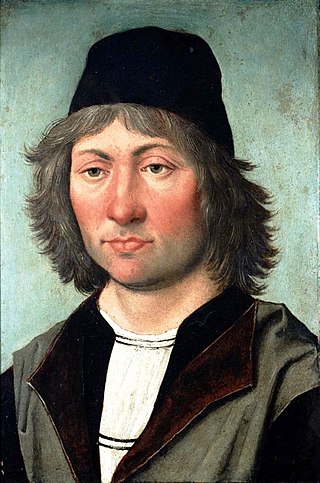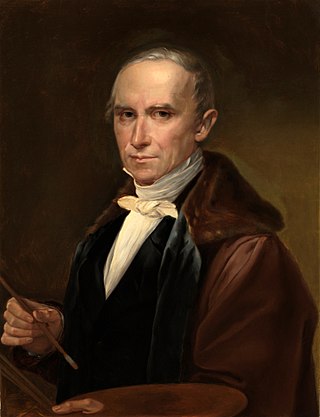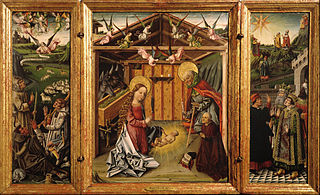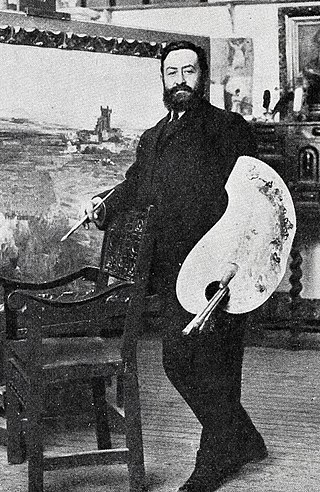
Diego de la Cruz (fl. 1482-1500) [1] was a Spanish painter who may have been of Flemish origin. He was active in Burgos and the neighboring region.

Diego de la Cruz (fl. 1482-1500) [1] was a Spanish painter who may have been of Flemish origin. He was active in Burgos and the neighboring region.
He was long forgotten, until being rediscovered in 1966, thanks to a study by José Gudiol Ricart, who proposed that he was born in Flanders around 1460 and arrived in Spain before the first group of Flemish painters arrived, led by Juan de Flandes. Other researchers, such as José Camón Aznar presumed that he was born in Spain; probably Castile. This viewpoint was supported by Didier Martens (born 1960), who published a study on the subject in 2001. [2] The influence upon his work by painters of the Burgundian Netherlands, such as Rogier van der Weyden, especially in his treatment of light, may be explained by their presence in Spain, rather than by his origins. Even Guidol suggests that he began as a sculptor and may have started his artistic career in the workshop of Gil de Siloé, who is believed to have been born in Antwerp.
His artistic personality is largely defined by two works: Cristo de Varón de Dolores entre la Virgen y San Juan, at the Museo del Prado; his only signed work, probably created between 1475-1480, and the Estigmatización de San Francisco de Asís at the Iglesia de San Esteban de Burgos (1487-1489). Based on an analysis of these works, it has been possible to make other attributions: notably, Cristo de Piedad entre dos ángeles at the Colegiata de Covarrubias , and the Cristo de Piedad entre los profetas David y Jeremías, the central tableau of the predella of an altarpiece and companion to two other tableaux (of the prophets Isaiah and Daniel) in the collection of the University of Liège, which have been attributed to the German painter, Hans Leonhard Schäufelein.

José Ignacio Javier Oriol Encarnación de Espronceda y Delgado was a Romantic Spanish poet, one of the most representative authors of the 19th century. He was influenced by Eugenio de Ochoa, Federico Madrazo, Alfred Tennyson, Richard Chenevix Trench and Diego de Alvear.

Luis de Morales was a Spanish painter active during the Spanish Renaissance in the 16th century. Known as "El Divino", most of his work was of religious subjects, including many representations of the Madonna and Child and the Passion.

Juan de Pareja was a Spanish painter born in Antequera, near Málaga, Spain. He is known primarily as a member of the household and workshop of painter Diego Velázquez, who enslaved him until 1650. His 1661 work The Calling of Saint Matthew is on display at the Museo del Prado in Madrid, Spain.

Pedro Berruguete was a Spanish painter whose art is regarded as a transitional style between Gothic and Renaissance art. Berruguete most famously created paintings of the first few years of the Inquisition and of religious imagery for Castilian retablos. He is considered by some as the first Renaissance painter in Spain.

Pedro de Orrente was a Spanish painter of the early Baroque period who became one of the first artists in that part of Spain to paint in a Naturalistic style.

Friar Juan Bautista Maíno, or Mayno was a Spanish Baroque painter.

José de Madrazo y Agudo was a Spanish painter and engraver; one of the primary exponents of the Neoclassical style in Spain. He was the patriarch of a family of artists that included his sons Federico and Luis; and his grandsons, Raimundo and Ricardo.

José Claudio Antolinez was a Spanish painter of the Baroque period.
Antonio Fernández Arias was a Spanish painter of the Baroque period.

Angelo Nardi da Razzo was an Italian painter of the early Baroque period; active primarily in Spain.

Gregorio Fernández was a Spanish Baroque sculptor. He belongs to the Castilian school of sculpture, following the style of other great artists like Alonso Berruguete, Juan de Juni, Pompeyo Leoni, and Juan de Arfe.

Antonio de Pereda y Salgado was a Spanish Baroque-era painter, best known for his still lifes.

Mateo Cerezo, sometimes referred to as The Younger was a Spanish Baroque painter; known primarily for religious works and still-lifes.

Doña Antonia de Ipeñarrieta y Galdós and Her Son Don Luis is a 1634 portrait by Diego Velázquez, now in the Prado Museum. Doña Antonia and her son Luis are shown standing, captured in an elegant melancholy. The woman uses the chair to support herself, to emphasize her social status in the Court, where she had the right to sit. According to different studies of the canvas, it is believed that the child's figure could have been added afterwards.

The Museo Municipal de Bellas Artes de Santa Cruz de Tenerife is a museum of fine arts located in the city of Santa Cruz de Tenerife. Its headquarters are located in the rear of the Church of St. Francis of Assisi.

Andrés Amaya was a Spanish Baroque painter in oils of religious subjects. He was active in the region of Castile and León, primarily in the city of Valladolid.

Francisco de Solís, was a Spanish painter in the Baroque style. He also collected drawings and compiled biographies of other Spanish painters.

The Master of Ávila, a painter in the Flemish style of Fernando Gallego, was active in Ávila and surroundings in the middle of the 15th century. The art historian Elías Tormo and others have tentatively identified him as García del Barco, a painter who was known to have been in Ávila between 1465 and 1473. No works by Barco have been attributed with any certainty.

Marceliano Santa María was a Spanish painter, noted for his Castilian landscapes, historical art, and portraits.